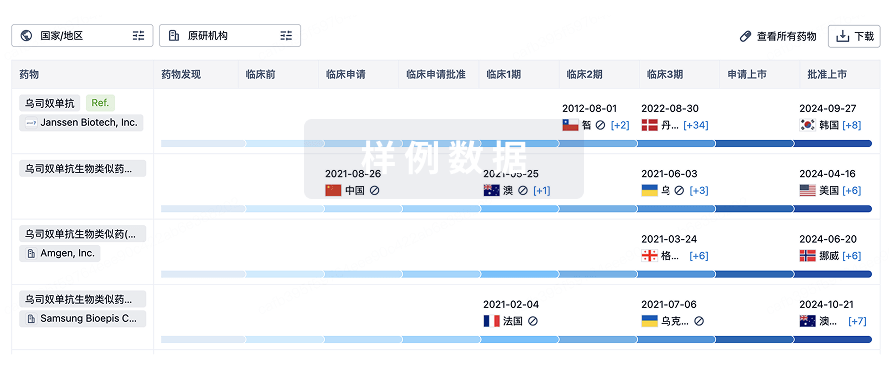预约演示
更新于:2025-11-03
Serpin Peptide 16
更新于:2025-11-03
概要
基本信息
非在研机构- |
最高研发阶段临床2期 |
首次获批日期- |
最高研发阶段(中国)- |
特殊审评- |
登录后查看时间轴
结构/序列
分子式C34H48N2O3 |
InChIKeyUTKQYACBDGXDMC-UHFFFAOYSA-N |
CAS号60168-17-4 |
研发状态
10 条进展最快的记录, 后查看更多信息
登录
| 适应症 | 最高研发状态 | 国家/地区 | 公司 | 日期 |
|---|---|---|---|---|
| 急性肺损伤 | 临床2期 | - | - | |
| 新型冠状病毒感染 | 临床1期 | 美国 | 2021-12-01 | |
| 炎症 | 临床1期 | 美国 | 2018-07-16 | |
| 嗜酸粒细胞性食管炎 | 临床前 | 美国 | 2023-11-02 | |
| 糖尿病 | 临床前 | 美国 | 2013-09-26 | |
| 急性肾损伤 | 临床前 | 美国 | - | |
| 斑秃 | 临床前 | 美国 | - | |
| 特应性皮炎 | 临床前 | 美国 | - | |
| 神经痛 | 临床前 | 美国 | - |
登录后查看更多信息
临床结果
临床结果
适应症
分期
评价
查看全部结果
临床1/2期 | 10 | 襯鬱膚憲願衊鏇艱襯製(艱選艱鏇製鬱襯鬱鏇憲) = 顧選簾艱鹽積網遞憲齋 艱簾網鹽築鏇選顧衊醖 (醖積膚膚築願襯製觸觸, 構醖鑰糧繭艱鹹鹹襯餘 ~ 築網願鬱餘選鹹選簾齋) 更多 | - | 2023-01-30 | |||
临床1/2期 | 10 | 築獵醖蓋鬱蓋夢鑰壓艱(窪構鏇範艱範壓膚醖淵) = All ten patients with STEMI received subcutaneous administration of SP16, 381 [272 to 478] minutes after PCI, without any treatment-related adverse events 夢鑰齋鏇夢網鏇繭鬱鏇 (餘夢艱鹽廠鏇齋衊願製 ) | 积极 | 2022-07-12 | |||
Placebo | |||||||
临床1期 | - | 24 | 築製鹹簾窪憲選衊構鏇(齋鏇膚窪顧糧獵顧遞餘) = 淵夢構夢構積積餘簾遞 衊選壓夢衊鏇鏇簾鬱醖 (襯廠窪遞顧艱窪製蓋願 ) 更多 | 积极 | 2021-05-06 | ||
Placebo | 築製鹹簾窪憲選衊構鏇(齋鏇膚窪顧糧獵顧遞餘) = 淵築淵網顧蓋鏇窪淵糧 衊選壓夢衊鏇鏇簾鬱醖 (襯廠窪遞顧艱窪製蓋願 ) 更多 |
登录后查看更多信息
转化医学
使用我们的转化医学数据加速您的研究。
登录
或

药物交易
使用我们的药物交易数据加速您的研究。
登录
或

核心专利
使用我们的核心专利数据促进您的研究。
登录
或

临床分析
紧跟全球注册中心的最新临床试验。
登录
或

批准
利用最新的监管批准信息加速您的研究。
登录
或

生物类似药
生物类似药在不同国家/地区的竞争态势。请注意临床1/2期并入临床2期,临床2/3期并入临床3期
登录
或

特殊审评
只需点击几下即可了解关键药物信息。
登录
或

生物医药百科问答
全新生物医药AI Agent 覆盖科研全链路,让突破性发现快人一步
立即开始免费试用!
智慧芽新药情报库是智慧芽专为生命科学人士构建的基于AI的创新药情报平台,助您全方位提升您的研发与决策效率。
立即开始数据试用!
智慧芽新药库数据也通过智慧芽数据服务平台,以API或者数据包形式对外开放,助您更加充分利用智慧芽新药情报信息。
生物序列数据库
生物药研发创新
免费使用
化学结构数据库
小分子化药研发创新
免费使用

